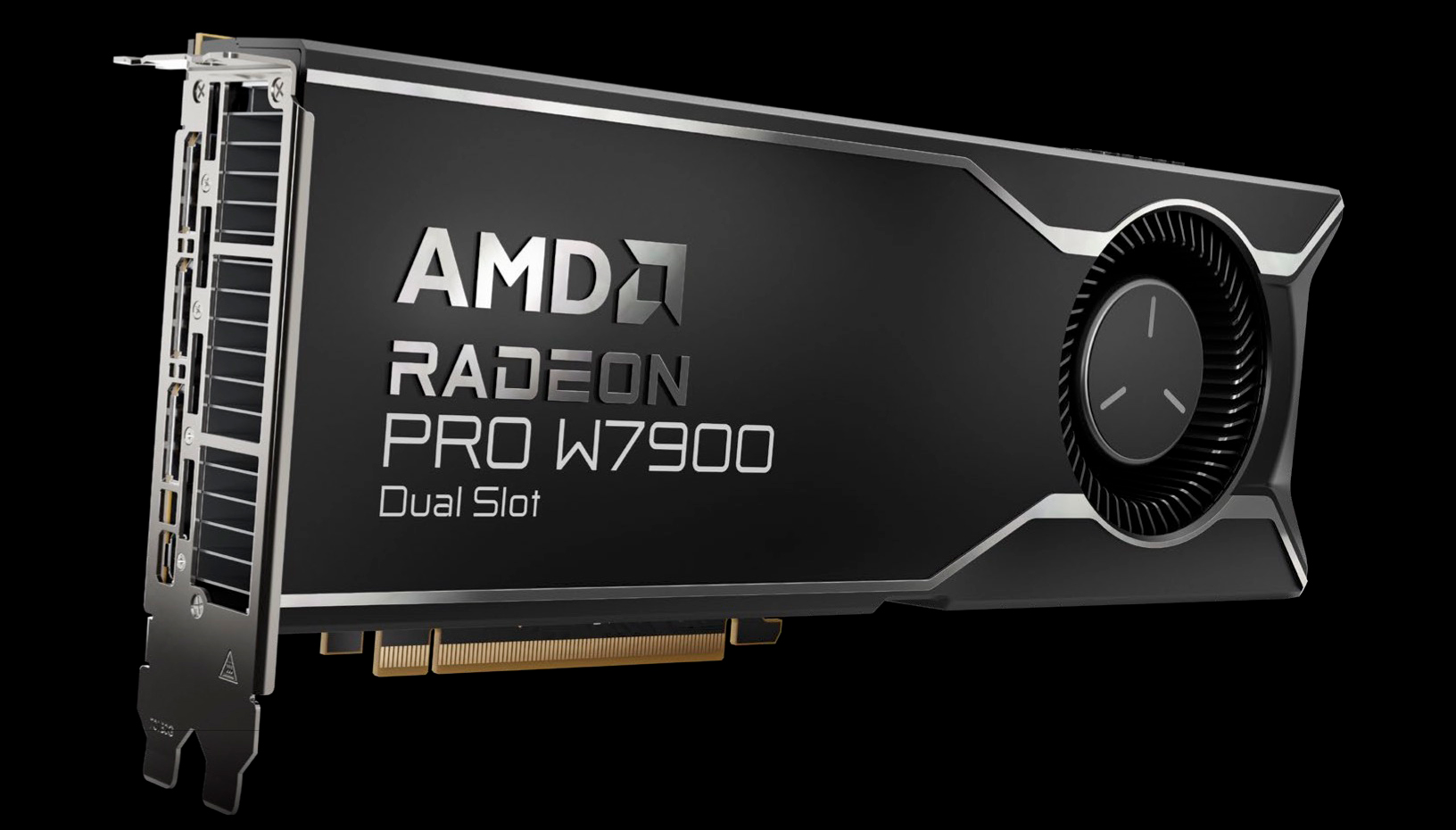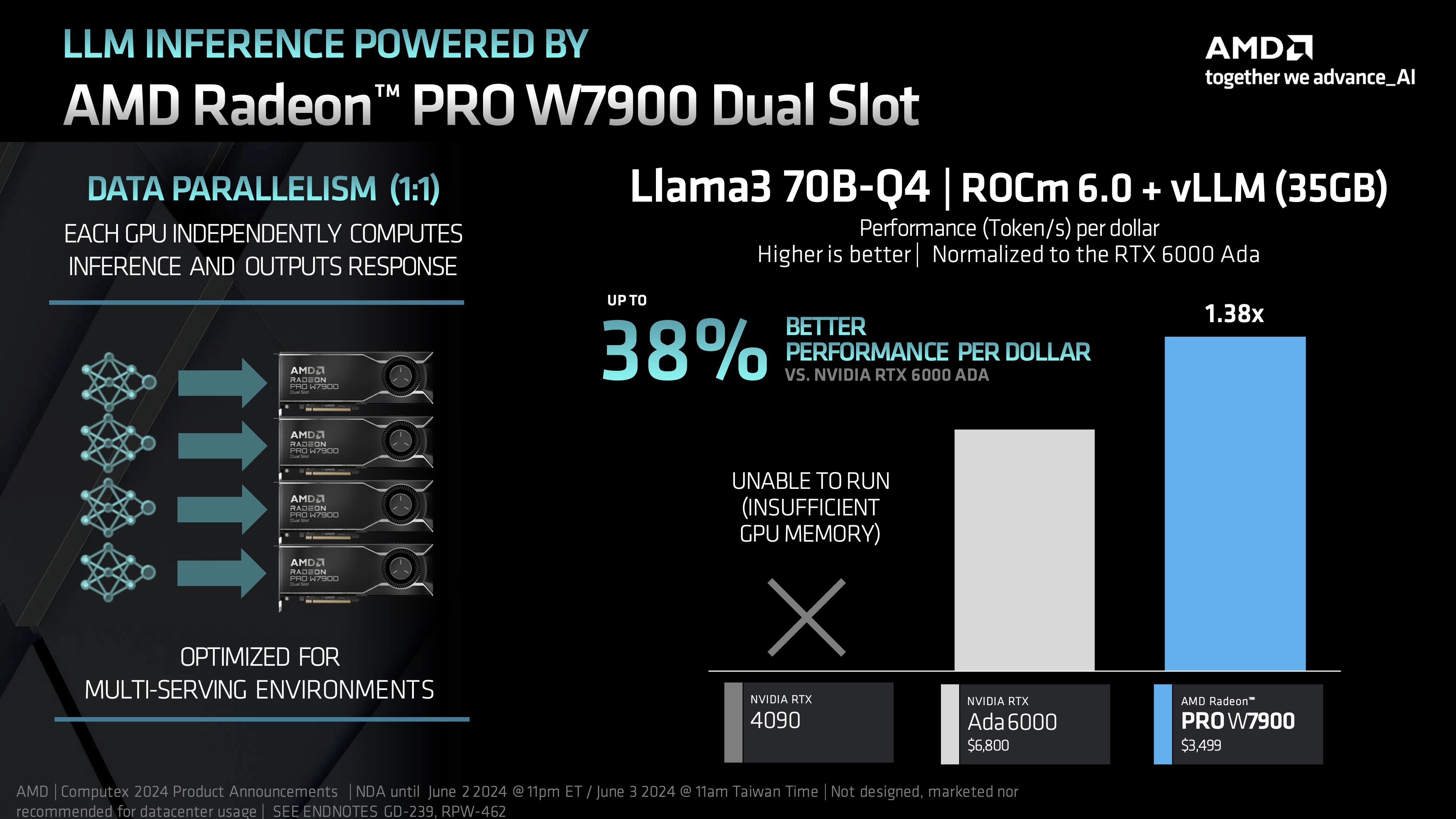AMD debuts Radeon Pro GPU for AI workloads — Radeon Pro W7900 Dual Slot brings 6,144 shaders and 48GB ECC GDDR6 for $3,499

AMD has announced a new addition to the chipmaker's Radeon Pro Navi lineup: the Radeon Pro W7900 Dual Slot. This is a more compact version of the already launched Radeon Pro W7900 without compromising performance.
The regular Radeon Pro W7900 is a monster RDNA 3-based professional graphics card launched last year. The Navi 31 powerhouse arrived with a triple-slot design, making it a bit bulky for multi-GPU configurations. Therefore, AMD has released the Radeon Pro W7900 Dual Slot, which, as the name implies, is the dual-slot version of the original. By trimming the graphics card to two slots with a board length of 11.02 inches (280 mm), AMD allows you to have up to four Radeon Pro W7900 Dual Slot cards in a single system. It still features the same blower-style design but takes up one less PCI slot.
Although the Radeon Pro W7900 Dual Slot flaunts a more slender body, AMD made no concessions regarding specifications. The graphics card still utilizes the full Navi 31 (Plum Bonito) silicon with 6,144 shaders, 96 Ray Tracing cores, 192 AI accelerators, and 96MB of Infinity Cache. Like the regular version, the Radeon Pro W7900 Dual Slot delivers a peak half precision (FP16) performance of up to 123 TFLOPS and memory bandwidth of up to 864 GB/s. The latter is possible thanks to the 48GB of ECC GDDR6 clocked at 18 Gb/s across a 384-bit memory interface.
The Radeon Pro W7900 Dual Slot maintains the 295W TDP like the standard variant. Unlike Nvidia, which is fond of the 16-pin power connector, AMD sticks with standard PCIe power connectors. The Radeon Pro W7900 Dual Slot requires two 8-pin PCIe power connectors. Despite losing body fat, the Radeon Pro W7900 Dual Slot offers the same amount of display connectors, consisting of three DisplayPort 2.1 outputs and one mini-DisplayPort 2.1 output.








AMD is pitting the Radeon Pro W7900 Dual Slot against Nvidia's RTX 6000 Ada, claiming that the Navi 31-powered graphics card offers professionals 52% better performance per dollar. The Radeon Pro W7900 Dual Slot targets AI workloads, so AMD highlighted the professional graphics card's prowess in tackling AI tasks. According to AMD, the Radeon Pro W7900 Dual Slot boasts up to 38% better AI performance per dollar than the RTX 6000 Ada. However, it's important to note that AMD's referring to more bang for your buck, not that the Radeon Pro W7900 Dual Slot wipes the floor with the RTX 6000 Ada in terms of pure performance.
The Radeon Pro W7900 debuted in 2023 for $3,999, but today, it is available for as little as $3,649.99 at the retail level. AMD is positioning the Radeon Pro W7900 below that with a $3,499 SEP (suggested etail pricing). It's a very aggressive price compared to the RTX 5000 Ada or the RTX 6000 Ada, retailing for $4,000 and $6,800, respectively. However, it's not always about price but rather the type of workload and the ecosystem that you're in. AMD's Radeon Pro W7900 Dual Slot will hit the market on June 19.
Get Tom's Hardware's best news and in-depth reviews, straight to your inbox.

Zhiye Liu is a news editor, memory reviewer, and SSD tester at Tom’s Hardware. Although he loves everything that’s hardware, he has a soft spot for CPUs, GPUs, and RAM.
-
PFTN1212 Amd W7900 crushes FP 16 on the Blackwell RTX Pro 6000Reply
I am creating an upgraded Lenovo P620 Thredipper Pro W/5975 32-core CPU and 512 GB Ram,
with 2 AMD Radeon Pro W7900 GPUs'S connected to 2 Highpoint external Chassis with 600 watt power supplies and 44 TB M.2 SSD drives .
After doing a deep dive on the W7900 and the NVIDIA RTX PRO 6000 Blackwell I determined that the 2 W7900 cards even running on PCIe 4 would give better performance with more stability.
It's 16 FP, and FP 32 are better. The colour difference is true colour. High external color precision on
AMD W7900 .
Since I do not run my card at 100% max Nvidia,s extra Cuda cores and ray tracers are not used, so they are never needed.
The AMD W7900 FP16 doubles that of the 6000 Blackwell,.
The AMD W7900 exceeds the 6000 blackwell in FP 32 , Tighter rounding, True colors.
b